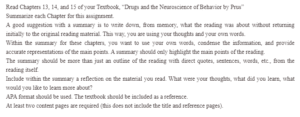Pharmacotherapeutic Management Strategies for Depressive and Bipolar Disorders
Chapter 13 of the book Drugs and the Neuroscience of Behavior by Adam J. Prus discusses the pharmacotherapeutic management strategies for depressive and Bipolar disorders. This Chapter discusses various mental disorders and the significance of the Diagnostic and Statistical Manual (DSM) tool in diagnosing these disorders. Of relevance in this Chapter are depression and bipolar disorders. Depression is a mental disorder characterized by displeasure in activities, alterations in body weight, fatigue, altered sleep patterns, and depressed mood, among others. A positive diagnosis of depression follows the occurrence of at least five of the stated symptoms within a two-week window. According to Lim et al., 2018, the prevalence of depression is high across all age groups as well as other social constructs.
The neurobiology of depressive disorders reveals the involvement of the amygdala, hippocampus, nucleus accumbens, and basal ganglia. These findings inform the pharmacological classes of drugs utilizable in the management of depression. These classes include tricyclic antidepressants, selective serotonin reuptake inhibitors, serotonin-norepinephrine reuptake inhibitors, and monoamine oxidase inhibitors, among others.
Bipolar disorder is described as a mental disorder characterized by abnormal shifts between manic and depressive mood phases. The manic phase of this disorder is more prominent in type 1 bipolar disorder compared to type 2 bipolar disorder. The neurobiology of this disorder indicates the involvement of the basal ganglia and the thalamus. Pharmacotherapy of bipolar disorder utilizes lithium, a mood stabilizer, as well as sodium valproate. Sodium valproate is preferred due to its tolerability (Morsel et al., 2018). Antidepressants and antipsychotics can also be utilized in the symptomatic management of this disorder.
The 14th Chapter of this book discusses the management of anxiety disorders. Anxiety disorders are described in this Chapter as disorders characterized by feelings of distress and worry over yet-to-happen events or unknown outcomes. These disorders are listed in DSM-5 and are described to further encompass phobias, panic disorders, social anxiety disorders, selective mutism, and generalized anxiety disorders. The neurobiology of these disorders reveals the involvement of the amygdala, cingulate cortex, and hippocampus.
Pharmacotherapy of anxiety disorders utilizes antidepressants, anxiolytics, and serotonin-receptor agonists, among others. Antidepressants maintain a central role in anxiety pharmacotherapy. This is due to their high efficacy, tolerability, and low abuse potential. CNS depressants and benzodiazepines have commonly been used as antianxiety drugs. The use of older CNS depressant drugs such as barbiturates has declined due to their toxicity profile and propensity for abuse. Other available agents are serotonergic drugs, with buspirone, a member of this class, being the most commonly used drug under this category.
Chapter 15 of this book discusses drugs utilized in the management of psychosis. The Chapter starts by discussing schizophrenia, a psychotic disorder that is characterized by troubled thinking processes, behavior abnormality, impairment in emotional processing, and delusions, among others. Schizophrenia is a DSM-listed mental disorder that presents with either negative or positive symptoms. Positive symptoms include delusions, hallucinations, movement disorders, and persecutory thoughts, among others. Negative symptoms of this disorder include disinterest or social withdrawal, emotional unresponsiveness, avolition, and lack of purpose, among others.
Schizophrenia is a lifelong disease that produces significant mental and cognitive impairment. Therapies have been developed that enhance the quality of living of these individuals. Antipsychotic drugs have been used in this regard. These drugs are antagonists of the dopamine D2 receptors. Antipsychotic drugs can be classified as either atypical or typical antipsychotics. Typical antipsychotics are the older agents that are efficacious against the positive symptoms. Typical antipsychotics, however, have been implicated in higher occurrence of extrapyramidal side effects; atypical agents are the newer agents that maintain efficacy for the positive symptoms and, to a lesser extent, negative symptoms. These agents have also been utilized in cognitive impairment. Their tolerability and inability to cause extrapyramidal side effects at therapeutic doses make them the preferred agents in schizophrenia. The Chapter concludes by discussing the utilization of antipsychotics in autistic disorders.
References
Lim, G., Tam, W., Lu, Y., Ho, C., Zhang, M., & Ho, R. (2018). Prevalence of Depression in the Community from 30 Countries between 1994 and 2014. Scientific Reports, 8(1). https://doi.org/10.1038/s41598-018-21243-x
Morsel, A., Morrens, M., & Sabbe, B. (2018). An overview of pharmacotherapy for bipolar I disorder. Expert Opinion On Pharmacotherapy, 19(3), 203-222. https://doi.org/10.1080/14656566.2018.1426746
Prus, A. An introduction to drugs and the neuroscience of behavior.
ORDER A PLAGIARISM-FREE PAPER HERE
We’ll write everything from scratch
Question

Pharmacotherapeutic Management Strategies for Depressive and Bipolar Disorders
Read Chapters 13, 14, and 15 of your Textbook, “Drugs and the Neuroscience of Behavior by Prus”
Summarize each Chapter for this assignment.
A good suggestion with a summary is to write down, from memory, what the reading was about without returning initially to the original reading material. This way, you are using your thoughts and your own words.
Within the summary for these chapters, you want to use your own words, condense the information, and provide accurate representations of the main points. A summary should only highlight the main points of the reading.
The summary should be more than just an outline of the reading with direct quotes, sentences, words, etc., from the reading itself.
Include within the summary a reflection on the material you read. What were your thoughts, what did you learn, what would you like to learn more about?
APA format should be used. The textbook should be included as a reference.
At least two content pages are required (this does not include the title and reference pages).


